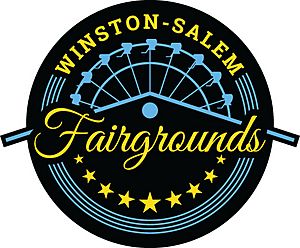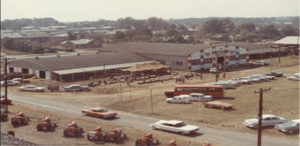Winston-Salem Fairgrounds facts for kids
 |
|
| Location | |
|---|---|
| Time zone | UTC−05:00 |
| Capacity | over 7,000 |
| Opened | 1929 (exclusively for horses and motorcycles) July 5, 1948 (for stock car racing) |
| Major events | SAFE Convertible NASCAR Modified Grand National Series |
| Dirt oval track | |
| Length | 0.500 mi (0.805 km) |
| Turns | 4 |
| Race lap record | 59.016 miles per hour (94.977 km/h) (Lee Petty, Petty Enterprises, August 7, 1955, NASCAR Grand National Series) |
The Winston-Salem Fairgrounds was a special place in Winston-Salem, North Carolina. It was known for two main things: being a fairground and a dirt race track. This track was a half-mile long and shaped like an oval.
Most of the year, the fairgrounds hosted the yearly Winston-Salem Fair, also known as the Dixie Classic Fair. This big event usually happened in the first week of October. The fairgrounds also held other fun events for the local area. In 1969, the fairgrounds and other buildings were given to the City of Winston-Salem.
Contents
Racing at the Fairgrounds
The race track at the fairgrounds was mainly used for NASCAR-style stock car racing. Stock car racing involves cars that look like regular cars but are built for racing. The track was part of the NASCAR Grand National Series until 1955.
Most races happened in the summer or early autumn. One race even took place on October 31, 1948, after the annual fair.
Famous Drivers and Races
Many famous drivers raced here. Lee Petty won two Grand National Series races in 1955. These races were held on May 29 and August 7. Another driver, Fred Dove, finished third in his last NASCAR Cup Series race at this track.
Other winners at the fairgrounds included Fonty Flock in a modified NASCAR car. Curtis Turner won a stock car race before the NASCAR Cup Series began. Jack Harrison won a race in the SAFE Convertible Series.
The SAFE Convertible Series
The SAFE (Society of Auto Sports, Fellowship, and Education) Convertible Series was a type of racing. NASCAR later bought this series and called it the NASCAR Convertible Division in 1955. However, this series did not last long. It ended in 1959 because regular sedan cars became safer and faster on the track than convertible cars.
Race Details and Speeds
The two main Cup Series races were about 100 miles (160 km) long. The biggest prize money for a race was $3,765.
Cars could reach speeds of up to 59.016 miles per hour (94.977 km/h) when racing alone. When many cars were on the track, the average speed was about 50.583 miles per hour (81.405 km/h). These speeds were slower than what modern cars can do on a highway today. Most races lasted less than two hours. The longest race was just under two hours.
All car racing stopped at the Winston-Salem Fairgrounds after 1963. It is not clear what happened to motorcycle and horse racing after that time.


